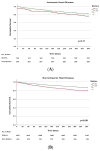Prognostic Impact of Statins in Heart Failure with Preserved Ejection Fraction
- PMID: 39407904
- PMCID: PMC11477314
- DOI: 10.3390/jcm13195844
Prognostic Impact of Statins in Heart Failure with Preserved Ejection Fraction
Abstract
Background: Heart failure (HF) with preserved ejection fraction (pEF) has lacked effective treatments for reducing mortality. However, previous studies have found an association between statin use and decreased mortality in patients with HFpEF. The aim of this study was to analyse whether statin therapy is associated with a reduction in mortality in these patients and whether the effect differs according to the presence or absence of ischaemic heart disease (IHD). Methods: We analysed data from the National Registry of Heart Failure, a prospective study that included patients admitted for HF in Internal Medicine units nationwide. Patients with HFpEF were classified according to the use of statins, and the differences between the two groups were analysed. A multivariable analysis was performed using Cox regression to assess factors independently related to mortality. Results: A total of 2788 patients with HFpEF were included; 63% of them were women with a mean age of 80.1 (±7.8) years. The statin-treated group (40.2%) was younger, with better functional status, and had a more common diagnosis of vascular disease and lower frequency of atrial fibrillation. The most frequent aetiology of HF in both groups was the hypertensive one. Nevertheless, ischaemic HF was more common in those who received statins (24.8% vs. 9.6%; p < 0.001). Multivariable analysis showed lower mortality at the 1-year follow-up in statin-treated patients (OR: 0.74; 95%CI: 0.61-0.89; p = 0.002). This association was observed in patients without IHD (p < 0.001) but not in those with IHD (p = 0.11). Conclusions: Statins are associated with a decrease in total mortality in patients with HFpEF. This benefit occurs mainly in those without IHD.
Keywords: heart failure; mortality; preserved ejection fraction; statins.
Conflict of interest statement
The authors declare that there are no conflicts of interest.
Figures
References
-
- Trullàs J.C., Pérez-Calvo J.I., Conde-Martel A., Iborra P.L., Pedreira I.S., Ormaechea G., Rangel L.S., Franco A.G., Cepeda J.M., Montero-Pérez-Barquero M. Epidemiology of heart failure with preserved ejection fraction: Results from the RICA Registry. Med. Clin. 2021;157:1–9. doi: 10.1016/j.medcli.2020.05.059. - DOI - PubMed
-
- Ponikowski P., Voors A.A., Anker S.D., Bueno H., Cleland J.G.F., Coats A.J.S., Falk V., González-Juanatey J.R., Harjola V.-P., Jankowska E.A., et al. 2016 ESC Guidelines for the Diagnosis and Treatment of Acute and Chronic Heart Failure. Eur. Heart J. 2016;37:2129–2200. doi: 10.1093/eurheartj/ehw128. - DOI - PubMed
-
- A McDonagh T., Metra M., Adamo M., Gardner R.S., Baumbach A., Böhm M., Burri H., Butler J., Čelutkienė J., Chioncel O., et al. 2023 Focused Update of the 2021 ESC Guidelines for the diagnosis and treatment of acute and chronic heart failure Developed by the task force for the diagnosis and treatment of acute and chronic heart failure of the European Society of Cardiology (ESC) with the special contribution of the Heart Failure Association (HFA) of the ESC. Eur. Heart J. 2023;44:3627–3639. doi: 10.1093/eurheartj/ehad195. - DOI - PubMed
-
- Solomon S.D., McMurray J.J., Claggett B., de Boer R.A., DeMets D., Hernandez A.F., Inzucchi S.E., Kosiborod M.N., Lam C.S., Martinez F., et al. Dapagliflozin in heart failure with mildly reduced or preserved ejection fraction. N. Engl. J. Med. 2022;387:1089–1098. doi: 10.1056/NEJMoa2206286. - DOI - PubMed
LinkOut - more resources
Full Text Sources
Research Materials
Miscellaneous



